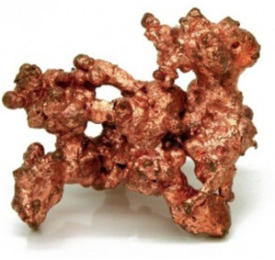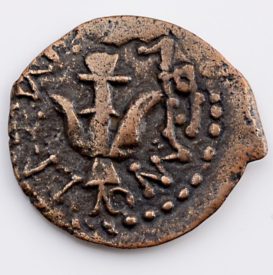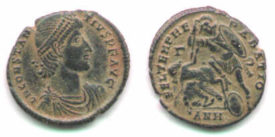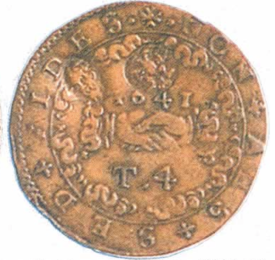“Take that copper!” ~ James Cagney, Angels With Dirty Faces,
Dir. Michael Curtiz; Warner Bros, 1938
 Right off the bat, copper is a very different metal. Like gold, it’s easy to work with for relatively simple tools and technologies, but unlike gold, copper was (and is) quite common and easy to find. Copper has been mined and used for at least 10,000 years and likely vied with meteoric iron as the metal most used in tools.
Right off the bat, copper is a very different metal. Like gold, it’s easy to work with for relatively simple tools and technologies, but unlike gold, copper was (and is) quite common and easy to find. Copper has been mined and used for at least 10,000 years and likely vied with meteoric iron as the metal most used in tools.
Copper’s history as money, is a different story. While gold and silver have almost always been traded as inherent objects of value, the value of copper has often been tied to its utility; a copper knife blade, for example, was worth more than a similar amount of copper (as economic theory would say it should be). Given the low value of copper relative to gold and silver, governments were not always as concerned with making copper (or copper alloys, like bronze) coins available.
Ancient Times
 There is evidence predating written history that copper was traded extensively across Europe, the Mideast, North Africa and Central Asia for other goods like shells, food, cloth, wine, slaves and livestock. There is also evidence that the copper trade ultimately drove the exploration for and trade of other metals, such as tin and lead. On its own, copper is quite soft, but in combination with other metals, such as tin, it makes the much stronger, much more useful bronze. Accordingly, bronze weapons, armor, and tools had great value above and beyond their copper content.
There is evidence predating written history that copper was traded extensively across Europe, the Mideast, North Africa and Central Asia for other goods like shells, food, cloth, wine, slaves and livestock. There is also evidence that the copper trade ultimately drove the exploration for and trade of other metals, such as tin and lead. On its own, copper is quite soft, but in combination with other metals, such as tin, it makes the much stronger, much more useful bronze. Accordingly, bronze weapons, armor, and tools had great value above and beyond their copper content.
Given the nature of the barter economies, it’s hard to characterize the value of copper as money or a trade good. Nevertheless, we know from historical records that 1 deben of copper (90 g) was worth 1 kit (9 g) of silver. We also know that a 58 kg sack of wheat traded for 2 debens. With wages for an unskilled laborer running at approximately 200 kg of grain per month, a day’s wage was worth something in the order of 31 g of copper – a price that works out to approximately $0.25 in today’s copper prices. Other known prices include 5 deben (450 g, or almost 1 pound) for a linen shirt and 140 deben for a cow. As is often the case, manufactured goods cost significantly more in the days before mass production.
It’s also worth noting that copper was more valuable to the Egyptians than it is to us today. In Ancient Egypt, a unit of copper was worth 1/100 that of silver, while today’s ratio is 1:120.
Greece and Rome
 Both the Greeks and Romans minted copper/bronze coinage; large hoards have been found buried across Europe. Unfortunately, much of the information we have about trade during that time excludes mention of copper coins. We know that they existed (and in fairly large quantities), but we don’t really know how they were used (or how often). What we do know is that the Greeks valued copper at a ratio of 1:350 with silver.
Both the Greeks and Romans minted copper/bronze coinage; large hoards have been found buried across Europe. Unfortunately, much of the information we have about trade during that time excludes mention of copper coins. We know that they existed (and in fairly large quantities), but we don’t really know how they were used (or how often). What we do know is that the Greeks valued copper at a ratio of 1:350 with silver.
Middle Ages
 Copper/bronze coinage was not minted regularly during the medieval period, as government mints focused on silver and gold coinage. Given that the large majority of the population was too poor to frequently conduct business with gold coins or large amounts of silver, the absence of copper coinage perpetuated trade through barter and credit.
Copper/bronze coinage was not minted regularly during the medieval period, as government mints focused on silver and gold coinage. Given that the large majority of the population was too poor to frequently conduct business with gold coins or large amounts of silver, the absence of copper coinage perpetuated trade through barter and credit.
The Byzantine empire was arguably the most active minter of low-value copper coinage, with the bronze folles amounting to 1:288 of the gold nomisma. Soldiers of the Byzantine empire were paid one gold nomisma per year of service. It was arguably the great emphasis on trade in the Byzantine empire that led to the significant production of bronze/copper coinage.
In the late 1500s, England did start minting a copper farthing under King James I, and the German and Italian states periodically produced copper coinage as well. However, copper’s most common use in European coinage was in debasing silver coinage – with Henry VIII famously swapping out as much of two-thirds of the silver content of coins with copper. As Europe moved into the 1700s, bronze coinage became more common, with most major governments producing them.
 Modern Era
Modern Era
Copper coinage has been in use for the entire history of the United States – whether in the form of coinage made in Europe and brought over in trade, locally minted colonial coinage, or the eventual half-cent and cent coins minted by the U.S. Mint. Although the modern world has grown accustomed to coins that are always the same size and weight, that has not been the historic norm. Particularly in the early years of U.S. coinage, the idea was that a coin should be worth the weight of the metal. Consequently, the weight of coins shifted with time as copper prices rose or fell relative to the fixed ratio of gold and silver.
Today, copper coinage is an afterthought. The coin most often thought of as copper, the cent, has actually been almost 98% zinc since 1983. At the same time, coins not normally thought of as copper are frequently made with copper clad in other metals; the nickel is 75% copper while the quarters and dimes minted for circulation are nearly 92% copper.
All the same, it is interesting to see how the value of copper has evolved. The large majority of copper is now used in wiring and piping, as well as in circuit boards, power generation and transmission, heating and cooling systems, and telecommunications equipment.
 The Bottom Line
The Bottom Line
From here on, the value of copper is likely to be tied to its utility in applications like wiring, electronics and manufacturing. Cheaper alternatives, such as plastic, have increasingly been replacing copper in finished goods and construction, but copper is still the preferred metal for a variety of electrical applications, including electrodes, turbines, generators and so on. It is also still a major input in renewable energy systems.
The world has all but entirely moved away from the idea that the metal content of a coin must have something to do with the value of the coin. Barring a complete re-thinking of fiat money and specie, that is unlikely to change. In fact, even copper coinage, historically the cheapest to produce and largely used only by the least well-do to in the economy, is now seen as antiquated and arguably too expensive.
Written by Daniela Pylypczak-Wasylyszyn and originally published by Commodity HQ ~ July 24, 2015.
NOTE: For further information about copper and bullion coinage, please visit our Copper Bullion Vault and review Take that Copper… , then CALL Kettle Moraine, Ltd. to discuss our current copper offerings.

Kettle Moraine, Ltd.
P.O. Box 579
Litchfield Park, AZ 85340
1-623-327-1778
gold@sierramadrepreciousmetals.com
 FAIR USE NOTICE: This site contains copyrighted material the use of which has not always been specifically authorized by the copyright owner. We are making such material available in our efforts to advance understanding of environmental, political, human rights, economic, democracy, scientific, and social justice issues, etc. We believe this constitutes a ‘fair use’ of any such copyrighted material as provided for in section 107 of the US Copyright Law. In accordance with Title 17 U. S. C. Section 107, the material on this site is distributed without profit to those who have expressed a prior interest in receiving the included information for research and educational purposes. For more information go to: http://www.law.cornell.edu/uscode/17/107.shtml
FAIR USE NOTICE: This site contains copyrighted material the use of which has not always been specifically authorized by the copyright owner. We are making such material available in our efforts to advance understanding of environmental, political, human rights, economic, democracy, scientific, and social justice issues, etc. We believe this constitutes a ‘fair use’ of any such copyrighted material as provided for in section 107 of the US Copyright Law. In accordance with Title 17 U. S. C. Section 107, the material on this site is distributed without profit to those who have expressed a prior interest in receiving the included information for research and educational purposes. For more information go to: http://www.law.cornell.edu/uscode/17/107.shtml








